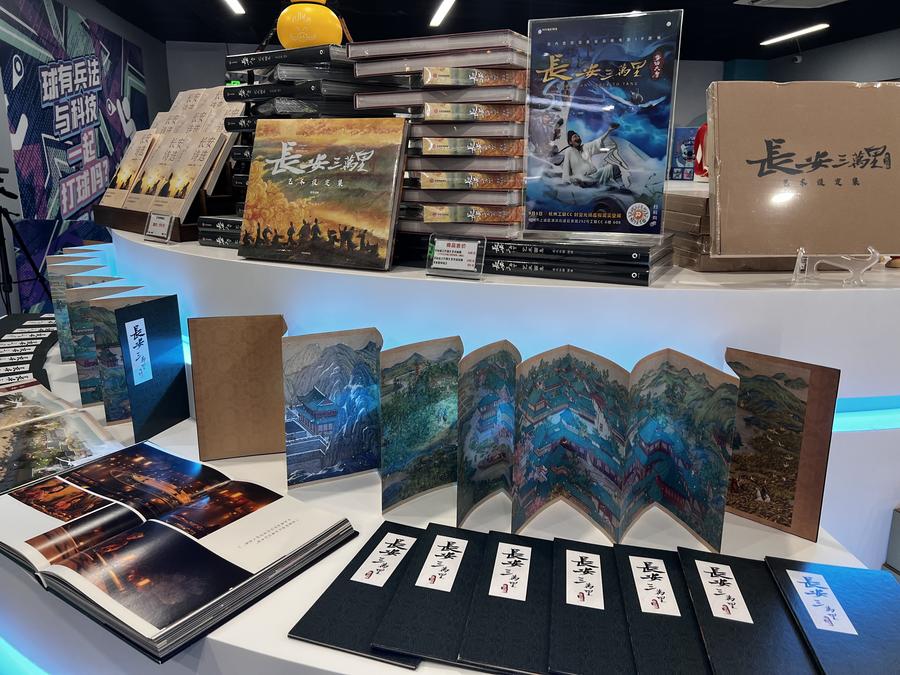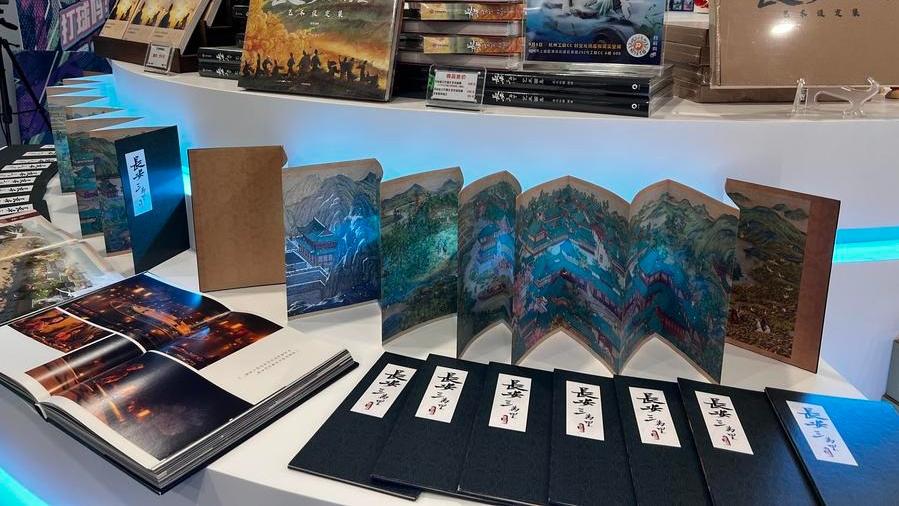
This photo taken on Nov. 14, 2025 shows creative products themed on "Chang An" displayed at a shop of Times Light Field in Gonglian City Center in Hangzhou, east China's Zhejiang Province. (Xinhua/Ji Hang)
HANGZHOU, Nov. 26 (Xinhua) -- China's consumption landscape is being reshaped by a new trend -- the pursuit of emotional fulfillment. As the country seeks to expand domestic demand, emotion-driven spending is becoming a core force in unlocking China's consumer potential.
From rearranging layouts and building social spaces to providing diverse experiences through the integration of technology and culture, the strategic evolution of shopping malls reflects the country's new trend of emotional consumption and new buying decisions.
LAYOUT REPOSITIONING, SOCIAL DESTINATION
Shopping malls are riding the wave of the new consumption trend by strategically repositioning brands, elevating trendy toy brands to prime retail space. The move leverages the market phenomenon driven by the massive success of IPs such as Nezha, Wukong, and Labubu, which have taken the market by storm through hit films, games and various cultural derivatives in recent years.
For instance, in China's economic powerhouse Shanghai, the mixed-use retail development Grand Gateway 66 introduced Pop Mart Collection and the brand's first jewelry store, Popop, on its first floor alongside established luxury and jewelry brands this year.
"During discussions about opening a new Pop Mart store, its concept for accessories stood out. Following its launch, Popop's initial sales have far exceeded our expectations," said Nicholas Poon, general manager of Grand Gateway 66, noting that the recent trendy IPs and related immersive experiences have effectively drawn young consumers and significantly increased customer flow to its catering tenants.
Poon added that brands that master emotional value, through stress relief, companionship or self-care, have seen a rise in popularity in recent years.
According to Poon, these brands are becoming increasingly sophisticated in terms of their product design and image shaping, with a strong online communication appeal. In addition to the brand portfolio, Grand Gateway 66 offers unique and immersive experiences that resonate with the growing desire among consumers for emotional fulfillment.
Beyond brand repositioning, malls in China are refining their public areas to establish themselves as a "third space" outside home and work. By incorporating interactive zones and thematic markets, they create environments for recharging and self-renewal, transforming malls into destinations for socializing and relaxation, rather than just shopping.
"The goal is to draw a broader consumer base and prolong customer stays," said Jacky Zhu, head of retail research, China of JLL, a real estate and investment management services firm. He explained that competition among malls has pivoted from the product mix alone to providing emotional experiences through a curated ambiance.
In east China's Zhejiang Province, another economic powerhouse, a shopping mall near West Lake called Gonglian City Center is one such game changer. Once a humble clothes market, it has now been transformed into a modern mall with popular IP products and multiple entertainment scenarios.
"Unlike traditional malls, our brand curation is far more flexible and aligned with the cultural pulse," said Wang Yongqiang, the mall's deputy general manager. He explained that by spotlighting innovative brands and creating social spaces, they aim to generate a compelling vibe that connects and resonates with people.
With such a strategy, Wang said that Gonglian City Center is expected to report retail sales of approximately one billion yuan (about 141.09 million U.S. dollars) this year, representing an average annual growth rate of 20 percent since 2019.
Customers Miao Zhiyue and Shao Wei told Xinhua that the primary draw is the ambiance itself. "We come here mainly to hang out and maybe pick up a few fun things. You don't mind spending a little when it puts you in a good mood," they said, noting their willingness to buy goods that provide genuine emotional benefit.
DIVERSIFIED COMPANIONSHIP
"At its core, emotional consumption fulfills psychological needs, redirecting spending toward personal well-being," said Zhang Linshan, a researcher at the Academy of Macroeconomic Research. He noted that the trend is in line with China's larger consumption shift toward services and experiences.
Zhang added that emerging sectors like AI companionship and emotional support services are creating new consumption scenarios and enriching the experience through cultural and technological integration.
Leveraging its location advantage in Hangzhou, a major tech hub in eastern China, Gonglian City Center draws consumers with a unique mix of cultural and technological services, for instance, VR experiences.
One particular immersive VR experience transports users into the world of "Chang An," an animated blockbuster. Users can interact with legendary Chinese poets Li Bai and Gao Shi, and even strike a pose to frame a virtual memory within the rectangle of their fingers.
"We may be newcomers to the mall, but we're certainly not newcomers to attracting customers," said Zhou Cheng, manager of the VR experience provider Times Light Field. She observed that the VR experience often drives sales, with many customers purchasing related cultural products on their way out.
Analysts believe China's policies to stimulate consumption are likely to grow stronger as the world's second-largest economy seeks to expand domestic demand to boost its economy.
The Communist Party of China Central Committee's recommendations for formulating the 15th Five-Year Plan (2026-2030) for China's economic and social development call for a notable increase in the GDP share of household consumption, and for strengthened inclusive policies that benefit consumers directly, among a series of measures to vigorously boost consumption.
To fully harness emotion-driven spending as a catalyst for unlocking consumer potential, a coordinated strategy across multiple dimensions is crucial, including diversified supply and institutional safeguards, according to Zhang.




 A single purchase
A single purchase









